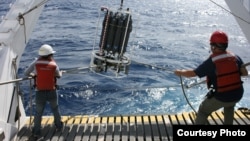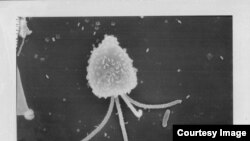Marine algae can detect a rainbow of light across the color spectrum, not just the blues and greens that penetrate ocean depths, according to a new study.
At Monterey Bay Aquarium Research Institute in California, Alexandra Worden and her colleagues sequenced the genetic makeup of 20 common marine algae, or phytoplankton, tiny marine plants that absorb carbon dioxide and are a vital food source in the ocean.
“We know that in these organisms about half of their genes have no known function, but of course, they are doing something,” she said.
Worden’s laboratory is trying to understand the function of those unknown genes, which may, she says, “reveal to us secrets about the sea, things we didn’t know we should be thinking about - chemicals or interactions with other organisms - that these genes are built to respond to, but we never knew we should be measuring.”
Detecting red
Like plants that live on land, phytoplankton also require light to grow and survive, and Worden was surprised to find genes in the marine microorganisms that detect many wavelengths of light - responding to a rainbow of colors, including red. She says the algae turn that light into a biological signal.
"[It tells] the cell to change, for instance, how the cell is growing or what genes are on and respond to this light cue in the environment,” she said.
Land plants have the same genes, which make them turn their leaves toward the sun, or grow taller to reach above neighboring plants that may be shading them. Worden suspects the gene in the single-celled marine algae may work in similar ways.
“It can’t be that they are using it to elongate a stem because they don’t have a stem," she said. "So they must be using it to detect that light and using it to reprogram their genes, but in response to maybe to where they are in the water column, something to do with depth in the water column for example.”
Adapting to ocean depth
And, as the planet warms, where these marine species live in that water column may affect how this master regulator gene functions.
“Warm water doesn’t mix as well with the lower water that has all the nutrients," she said. "And so if they developed to detect a wavelength that is present at 30 meters in the water column, but now they have to live at 10 meters due to these changes in the ocean structure, what is that going to mean? Will they be able to use this protein to reprogram their cellular activities at that time?”
Worden says the mechanism, described in the Proceedings of the National Academy of Sciences, adds an important new parameter to assess the ecology of the ocean.
“Normally we go and measure nitrogen or we go and measure phosphate, the same kinds of fertilizers we put in plants," she said."Those are the things we measure in the ocean and say, ‘Oh, there is low nitrogen, maybe it is hard for them to grow right now.' Well, now we know we actually also have to be very sensitive, not just to how much light, but to the wavelengths of light that are available.”
Worden says what her lab is learning about algae could also help with food production by introducing new ways to engineer crops to grow in many light conditions.
At Monterey Bay Aquarium Research Institute in California, Alexandra Worden and her colleagues sequenced the genetic makeup of 20 common marine algae, or phytoplankton, tiny marine plants that absorb carbon dioxide and are a vital food source in the ocean.
“We know that in these organisms about half of their genes have no known function, but of course, they are doing something,” she said.
Worden’s laboratory is trying to understand the function of those unknown genes, which may, she says, “reveal to us secrets about the sea, things we didn’t know we should be thinking about - chemicals or interactions with other organisms - that these genes are built to respond to, but we never knew we should be measuring.”
Detecting red
Like plants that live on land, phytoplankton also require light to grow and survive, and Worden was surprised to find genes in the marine microorganisms that detect many wavelengths of light - responding to a rainbow of colors, including red. She says the algae turn that light into a biological signal.
"[It tells] the cell to change, for instance, how the cell is growing or what genes are on and respond to this light cue in the environment,” she said.
Land plants have the same genes, which make them turn their leaves toward the sun, or grow taller to reach above neighboring plants that may be shading them. Worden suspects the gene in the single-celled marine algae may work in similar ways.
“It can’t be that they are using it to elongate a stem because they don’t have a stem," she said. "So they must be using it to detect that light and using it to reprogram their genes, but in response to maybe to where they are in the water column, something to do with depth in the water column for example.”
Adapting to ocean depth
And, as the planet warms, where these marine species live in that water column may affect how this master regulator gene functions.
“Warm water doesn’t mix as well with the lower water that has all the nutrients," she said. "And so if they developed to detect a wavelength that is present at 30 meters in the water column, but now they have to live at 10 meters due to these changes in the ocean structure, what is that going to mean? Will they be able to use this protein to reprogram their cellular activities at that time?”
Worden says the mechanism, described in the Proceedings of the National Academy of Sciences, adds an important new parameter to assess the ecology of the ocean.
“Normally we go and measure nitrogen or we go and measure phosphate, the same kinds of fertilizers we put in plants," she said."Those are the things we measure in the ocean and say, ‘Oh, there is low nitrogen, maybe it is hard for them to grow right now.' Well, now we know we actually also have to be very sensitive, not just to how much light, but to the wavelengths of light that are available.”
Worden says what her lab is learning about algae could also help with food production by introducing new ways to engineer crops to grow in many light conditions.









